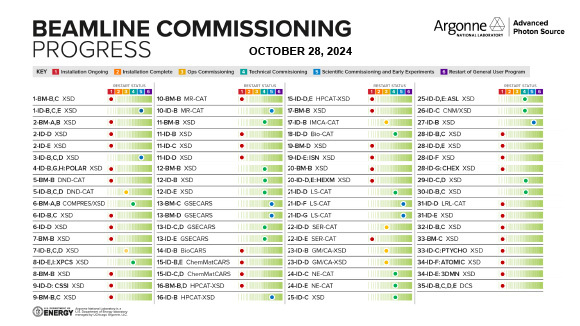Progress Along Two Tracks
The Advanced Photon Source is now in a very interesting hybrid stage.
On the one hand, users are back at a number of our beamlines and early scientific experiments are occurring. On the graphic below you can see the progress our dedicated teams are making to deliver X-ray beams to our beamlines – we now have nine accepting users for experiments, and more scheduled to join them every week. You can find the progress graphic on our website, and it's updated every Monday.
With users back on the floor and more than 30 beamlines in commissioning, the APS has become a home for scientific discovery again after a year-long shutdown, and it's remarkable to see. More than a decade of work on the upgraded facility is now in the rear-view mirror, and we’re beginning to see what users will do with it. The call has gone out for proposals for our first user run of 2025, which begins in January. More information is on the website.
On the other hand, the APS is also still a construction site as we continue to build new feature beamlines and complete enhancements and alignments. If you are on site, you'll see that we're completing the long beam transport pipes leading out to the High-Energy X-ray Microscope (HEXM) and the In-Situ Nanoprobe (ISN) in our Long Beamline Building. We're nearing completion of the POLAR beamline at 4-ID, and performing other installation activities in more than 25 sectors around the experiment floor.
In our internal communications we have focused on safety during this time, and I think that's also an important message for our user community as you prepare to resume on-site experiments. If you're here, please keep aware of your surroundings and any safety postings, wear the proper personal protective equipment and keep the safety of yourself and others in the front of your mind. Nothing is more important.
One more thing for this month: I wanted to extend my congratulations to David Baker of the University of Washington, who received the 2024 Nobel Prize in chemistry for his work on protein folding using artificial intelligence. Baker's published work has made use of data collected at the APS for more than a decade, and he has used the resources of the Argonne Leadership Computing Facility as well. It's great to see his work recognized.
Until next month, be safe and be well.
Sincerely,
Jonathan Lang
Director, X-ray Science Division

